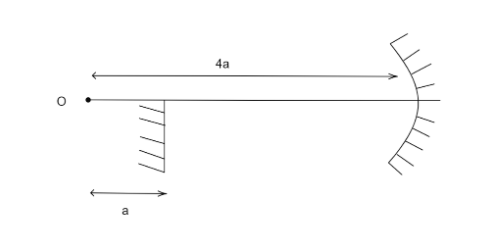
The diagram shows a mirror system. If after two reflections the image and the object O coincide with each other, then the value of the radius of curvature of the concave mirror is: (take $a = 3m$)

(A) $4m$
(B) $6m$
(C) $8m$
(D) $10m$
Answer
216.3k+ views
Hint The radius of the curvature of a mirror is twice of its focal length. Focal length can easily be calculated if the image and object position is given. For a plane mirror, the object distance is equal to image distance.
Step by step solution
Two conditions are given for this problem. First, the object is kept at O, i.e. a distance $4a$ from the concave mirror. Second, the final image after reflection from the plane mirror forms at O i.e. at a distance of $a$ behind the plane mirror.
Since object distance and image distance are always equal for a plane mirror, we can say that the object for the plane mirror is placed at position $P$
Using the given condition that reflection takes place twice, we can conclude that first, it reflects from the concave mirror and then from the plane mirror to make the final image at O. This implies that the object for the plane mirror is actually the image from the concave mirror.
So, we have the object distance and image distance for the concave mirror.
$u = - 4a$
And, $v = - 2a$.
Where, $u$ object distance
$v$ is the image distance.
The negative sign represents that these coordinates are on the left side of the pole of the mirror.
Using mirror formula,
$\dfrac{1}{v} + \dfrac{1}{u} = \dfrac{1}{f}$
Putting the values, we get
$\dfrac{1}{{ - 2a}} + \dfrac{1}{{ - 4a}} = \dfrac{1}{f}$
$ \Rightarrow \dfrac{{ - 2 - 1}}{{4a}} = \dfrac{1}{f}$
Solving this
$\dfrac{1}{f} = \dfrac{{ - 3}}{{4a}}$
We know that, radius of curvature of a mirror is given by twice its focal length.
$R = 2f$
$ \Rightarrow R = 2\left( {\dfrac{{ - 4a}}{3}} \right)$
Putting $a = 3m$, we get
$R = 8m$.
Hence, Option (C) is correct.
Note The basic concept is to remember the mirror formulas. You should be careful if you are taking the numeric value of the image and object distance because it can easily lead you to error. A better way is to solve it first and then put the numeric value.
Step by step solution
Two conditions are given for this problem. First, the object is kept at O, i.e. a distance $4a$ from the concave mirror. Second, the final image after reflection from the plane mirror forms at O i.e. at a distance of $a$ behind the plane mirror.
Since object distance and image distance are always equal for a plane mirror, we can say that the object for the plane mirror is placed at position $P$
Using the given condition that reflection takes place twice, we can conclude that first, it reflects from the concave mirror and then from the plane mirror to make the final image at O. This implies that the object for the plane mirror is actually the image from the concave mirror.
So, we have the object distance and image distance for the concave mirror.
$u = - 4a$
And, $v = - 2a$.
Where, $u$ object distance
$v$ is the image distance.
The negative sign represents that these coordinates are on the left side of the pole of the mirror.
Using mirror formula,
$\dfrac{1}{v} + \dfrac{1}{u} = \dfrac{1}{f}$
Putting the values, we get
$\dfrac{1}{{ - 2a}} + \dfrac{1}{{ - 4a}} = \dfrac{1}{f}$
$ \Rightarrow \dfrac{{ - 2 - 1}}{{4a}} = \dfrac{1}{f}$
Solving this
$\dfrac{1}{f} = \dfrac{{ - 3}}{{4a}}$
We know that, radius of curvature of a mirror is given by twice its focal length.
$R = 2f$
$ \Rightarrow R = 2\left( {\dfrac{{ - 4a}}{3}} \right)$
Putting $a = 3m$, we get
$R = 8m$.
Hence, Option (C) is correct.
Note The basic concept is to remember the mirror formulas. You should be careful if you are taking the numeric value of the image and object distance because it can easily lead you to error. A better way is to solve it first and then put the numeric value.
Recently Updated Pages
Wheatstone Bridge Explained: Working, Formula & Uses

Young’s Double Slit Experiment Derivation Explained

JEE Atomic Structure and Chemical Bonding important Concepts and Tips

JEE Amino Acids and Peptides Important Concepts and Tips for Exam Preparation

Electricity and Magnetism Explained: Key Concepts & Applications

Chemical Properties of Hydrogen - Important Concepts for JEE Exam Preparation

Trending doubts
JEE Main 2026: Application Form Open, Exam Dates, Syllabus, Eligibility & Question Papers

Derivation of Equation of Trajectory Explained for Students

Hybridisation in Chemistry – Concept, Types & Applications

Understanding the Angle of Deviation in a Prism

Understanding Collisions: Types and Examples for Students

How to Convert a Galvanometer into an Ammeter or Voltmeter

Other Pages
JEE Advanced Marks vs Ranks 2025: Understanding Category-wise Qualifying Marks and Previous Year Cut-offs

Ideal and Non-Ideal Solutions Explained for Class 12 Chemistry

Degree of Dissociation: Meaning, Formula, Calculation & Uses

Understanding Electromagnetic Waves and Their Importance

Understanding the Electric Field of a Uniformly Charged Ring

Understanding Average and RMS Value in Electrical Circuits




